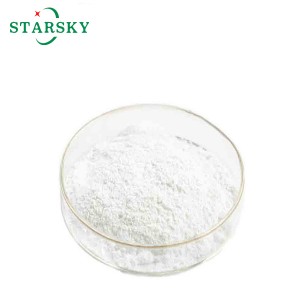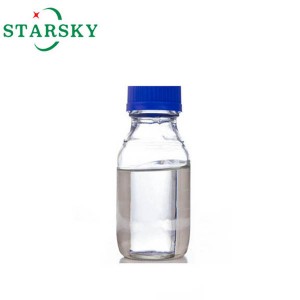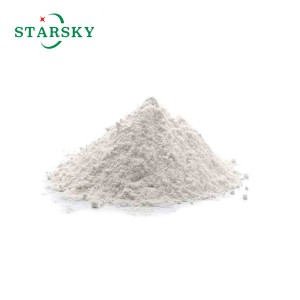-

Calcium acetate CAS 62-54-4
Calcium acetate cas 62-54-4 is used as a chelating agent, mold inhibitor, stabilizer, buffering agent, fragrance enhancer, preservative, and nutritional fortifier PH regulator, processing aid.
More detailed information, welcome to contact us.
WhatsApp:+86 18317156592
-

Tianeptine sodium salt cas 30123-17-2
Tianeptine sodium salt 30123-17-2 is typically a white to off-white crystalline powder. It is the salt form of tianeptine, an antidepressant. The appearance may vary slightly depending on the specific formulation and manufacturer, but is generally characterized by its crystal structure and color.
Tianeptine sodium salt is generally soluble in water. It has good solubility due to its sodium salt form, which enhances its solubility in aqueous solutions. This property makes it suitable for a variety of pharmaceutical formulations.
-

Tetrachloroethylene cas 127-18-4
Tetrachloroethylene is a colorless liquid with a sweet odor. It is non-flammable and has a density greater than water. In its pure state, it appears as a clear, volatile liquid. Tetrachloroethylene is commonly used as a solvent in dry cleaning and various industrial applications.
Tetrachloroethylene cas 127-18-4 is insoluble in water; its solubility in water is very low (approximately 0.01 g/100 mL at 25°C). However, it is soluble in organic solvents such as alcohols, ethers, and hydrocarbons. This property makes it useful in a variety of industrial applications, particularly as a solvent in dry cleaning and degreasing processes.
-

2-Methylimidazole CAS 693-98-1
2-Methylimidazole is a colorless to pale yellow liquid or solid, depending on its form and purity. It has a characteristic odor and is hygroscopic, meaning it absorbs moisture from the air. In its pure state, it is usually a crystalline solid.
2-Methylimidazole is soluble in water and also in polar organic solvents such as ethanol and methanol. Its solubility in water makes it useful in a variety of applications, including as a catalyst and in biochemical processes. The compound is soluble in these solvents due to its polar nature and the presence of nitrogen atoms in its structure, which can form hydrogen bonds with water and other polar molecules.
-

2-Ethylimidazole cas 1072-62-4
2-Ethylimidazole is a colorless to pale yellow liquid with a characteristic amine-like odor.
2-Ethylimidazole cas 1072-62-4 is a heterocyclic organic compound containing an imidazole ring with an ethyl group attached to the second carbon.
The compound is commonly used in a variety of applications, including as a curing agent for epoxy resins and in the synthesis of pharmaceuticals and agrochemicals.
In terms of its physical properties, it has a boiling point of about 170-172 °C and is soluble in water and organic solvents.
-

Benzyl alcohol CAS 100-51-6
Benzyl alcohol is a colorless liquid with a mild, pleasant aromatic odor. It has a slightly oily texture and is often used as a solvent and in the formulation of various products, including cosmetics and pharmaceuticals. Pure benzyl alcohol is usually clear and transparent.
Benzyl alcohol is soluble in water, with a solubility of about 4 g/100 mL at room temperature. It is also soluble in organic solvents such as ethanol, ether, and chloroform. This solubility property makes benzyl alcohol useful in a variety of applications, including as a solvent in pharmaceuticals and cosmetics.
-

2 5-Furandimethanol CAS 1883-75-6
2,5-Furandimethanol is a chemical compound that appears as a colorless to pale yellow liquid or solid, depending on its state and purity. It has a sweet, slightly aromatic odor.
2,5-Furandiethanol is generally soluble in water due to its hydroxymethyl groups which can form hydrogen bonds with water molecules. It is also soluble in a variety of organic solvents such as ethanol and methanol. Solubility varies with concentration and temperature, but in general, it has good solubility in polar solvents.
-

8-Hydroxyquinoline CAS 148-24-3
8-Hydroxyquinoline is white crystalline powder. It has a characteristic odor and is soluble in organic solvents such as ethanol and ether, but not very soluble in water.
8-Hydroxyquinoline has a moderate solubility in water. It is more soluble in organic solvents such as ethanol, methanol, acetone, and chloroform. Its solubility properties make it useful in a variety of applications, including as a chelating agent for metal ions in solution.
-

Lithium carbonate CAS 554-13-2
Lithium carbonate (Li2CO3) is typically found as a white, odorless, crystalline powder or solid. It is commonly used for a variety of purposes, including treating bipolar disorder, as a mood stabilizer, and in the production of ceramics and glass. Pure lithium carbonate is typically found as a fine white powder, but larger crystalline forms are also available.
Lithium carbonate (Li2CO3) is slightly soluble in water. It is more soluble in hot water than in cold water. In addition, lithium carbonate is soluble in some organic solvents, but its solubility in water is relatively low compared to many other salts.
-

Bismuth oxide CAS 1304-76-3
Bismuth oxide (Bi₂O₃) is light yellow powder. bismuth oxide is used in a variety of applications, including ceramics, pigments, and catalysts in chemical reactions. In its bulk form, it can appear as a yellow solid.
Bismuth oxide (Bi₂O₃) is generally considered insoluble in water. However, it can be dissolved in strong acids, such as hydrochloric acid (HCl) and nitric acid (HNO₃), to form bismuth salts. Its solubility can vary depending on the specific form of bismuth oxide and solution conditions. In general, for practical purposes, it is considered insoluble in most common solvents.
-

Salicylic acid CAS 69-72-7
Salicylic acid cas 69-72-7 is an important raw material for fine chemicals such as pharmaceuticals, fragrances, dyes, and rubber additives.
-

Manufacture supplier Sodium acetate CAS 127-09-3
Sodium acetate CAS 127-09-3 with best price











